Soil-Available Nitrogen and Phosphorus and Their Temporal Stability in the Tibetan Grasslands
Abstract
1. Introduction
2. Materials and Methods
2.1. Data
2.2. Statistical Analyses
3. Results
3.1. The Relative Contributions of Climate Warming, Precipitation Change, and Radiation Change
3.2. The Relationship Between Relative Changes in Soil-Available Nitrogen and Phosphorus and Their Temporal Stability
3.3. Comparisons of Sensitivity Between Soil-Available Nitrogen and Phosphorus and Their Temporal Stability
4. Discussion
5. Conclusions
Supplementary Materials
Author Contributions
Funding
Data Availability Statement
Conflicts of Interest
References
- Ding, R.; Qin, Y.; Li, T.Y.; Fu, G. Exploring spatiotemporal dynamics in temporal stability of soil carbon, nitrogen, phosphorus, and pH in Tibetan grasslands. Geoderma 2024, 451, 117062. [Google Scholar] [CrossRef]
- Mahaut, L.; Choler, P.; Denelle, P.; Garnier, E.; Thuiller, W.; Kattge, J.; Lemauviel-Lavenant, S.; Lavorel, S.; Munoz, F.; Renard, D.; et al. Trade-offs and synergies between ecosystem productivity and stability in temperate grasslands. Glob. Ecol. Biogeogr. 2023, 32, 561–572. [Google Scholar] [CrossRef]
- Liu, J.S.; Li, X.F.; Ma, Q.H.; Zhang, X.; Chen, Y.; Isbell, F.; Wang, D.L. Nitrogen addition reduced ecosystem stability regardless of its impacts on plant diversity. J. Ecol. 2019, 107, 2427–2435. [Google Scholar] [CrossRef]
- Zelnik, Y.R.; Arnoldi, J.F.; Loreau, M. The Impact of Spatial and Temporal Dimensions of Disturbances on Ecosystem Stability. Front. Ecol. Evol. 2018, 6, 224. [Google Scholar] [CrossRef]
- Yang, G.J.; Hautier, Y.; Zhang, Z.J.; Lu, X.T.; Han, X.G. Decoupled responses of above- and below-ground stability of productivity to nitrogen addition at the local and larger spatial scale. Glob. Change Biol. 2022, 28, 2711–2720. [Google Scholar] [CrossRef] [PubMed]
- Wang, Y.; Ren, Z.; Ma, P.P.; Wang, Z.M.; Niu, D.C.; Fu, H.; Elser, J.J. Effects of grassland degradation on ecological stoichiometry of soil ecosystems on the Qinghai-Tibet Plateau. Sci. Total Environ. 2020, 722, 137910. [Google Scholar] [CrossRef]
- Dolezal, J.; Fibich, P.; Altman, J.; Leps, J.; Uemura, S.; Takahashi, K.; Hara, T. Determinants of ecosystem stability in a diverse temperate forest. Oikos 2020, 129, 1692–1703. [Google Scholar] [CrossRef]
- Sha, Z.Y.; Xie, Y.C.; Tan, X.C.; Bai, Y.F.; Li, J.; Liu, X.F. Assessing the impacts of human activities and climate variations on grassland productivity by partial least squares structural equation modeling (PLS-SEM). J. Arid Land 2017, 9, 473–488. [Google Scholar] [CrossRef]
- Zhang, T.; Zhang, Y.J.; Xu, M.J.; Zhu, J.T.; Chen, N.; Jiang, Y.B.; Huang, K.; Zu, J.X.; Liu, Y.J.; Yu, G.R. Water availability is more important than temperature in driving the carbon fluxes of an alpine meadow on the Tibetan Plateau. Agric. For. Meteorol. 2018, 256, 22–31. [Google Scholar] [CrossRef]
- Zhang, X.Z.; Shen, Z.X.; Fu, G. A meta-analysis of the effects of experimental warming on soil carbon and nitrogen dynamics on the Tibetan Plateau. Appl. Soil Ecol. 2015, 87, 32–38. [Google Scholar] [CrossRef]
- Wang, C.; Long, R.; Wang, Q.; Jing, Z.; Shang, Z.; Ding, L. Distribution of organic matter, nitrogen and phosphorus along an altitude gradient and productivity change and their relationships with environmental factors in the Alpine meadow. Acta Prataculturae Sin. 2005, 14, 15–20. [Google Scholar]
- Tian, L.M.; Zhao, L.; Wu, X.D.; Hu, G.J.; Fang, H.B.; Zhao, Y.H.; Sheng, Y.; Chen, J.; Wu, J.C.; Li, W.P.; et al. Variations in soil nutrient availability across Tibetan grassland from the 1980s to 2010s. Geoderma 2019, 338, 197–205. [Google Scholar] [CrossRef]
- Du, Y.G.; Ke, X.; Guo, X.W.; Cao, G.M.; Zhou, H.K. Soil and plant community characteristics under long-term continuous grazing of different intensities in an alpine meadow on the Tibetan plateau. Biochem. Syst. Ecol. 2019, 85, 72–75. [Google Scholar] [CrossRef]
- Jiang, L.L.; Wang, S.P.; Pang, Z.; Wang, C.S.; Meng, F.D.; Lan, Z.C.; Zhou, X.Q.; Li, Y.M.; Zhang, Z.H.; Luo, C.Y.; et al. Abiotic and biotic controls of soil dissolved organic nitrogen along a precipitation gradient on the Tibetan plateau. Plant Soil 2021, 459, 65–78. [Google Scholar] [CrossRef]
- He, Y.C.; Sun, J.; Xiong, J.N.; Shang, H.; Wang, X. Patterns, Dynamics, and Drivers of Soil Available Nitrogen and Phosphorus in Alpine Grasslands across the QingZang Plateau. Remote Sens. 2022, 14, 4929. [Google Scholar] [CrossRef]
- Wang, Z.; Wang, J.; Huang, L.; Shao, M.A. Patterns and driving factors of soil nutrient stoichiometry under three land use types in the alpine region of Tibet, China. J. Soils Sediments 2024, 24, 901–913. [Google Scholar] [CrossRef]
- Closa, I.; Irigoyen, J.J.; Goicoechea, N. Microclimatic conditions determined by stem density influence leaf anatomy and leaf physiology of beech (Fagus sylvatica L.) growing within stands that naturally regenerate from clear-cutting. Trees-Struct. Funct. 2010, 24, 1029–1043. [Google Scholar] [CrossRef]
- Li, R.; Zhao, L.; Ding, Y.J.; Shen, Y.P.; Du, E.J.; Liu, G.Y. The Effect of Global Radiation Budget on Seasonal Frozen Depth in the Tibetan Plateau. J. Glaciol. Geocryol. 2009, 31, 422–430. [Google Scholar]
- Méndez, M.S.; Martinez, M.L.; Araujo, P.I.; Austin, A.T. Solar radiation exposure accelerates decomposition and biotic activity in surface litter but not soil in a semiarid woodland ecosystem in Patagonia, Argentina. Plant Soil 2019, 445, 483–496. [Google Scholar] [CrossRef]
- Fu, G.; Sun, W.; Li, S.; Zhang, J.; Yu, C.; Shen, Z. Modeling aboveground biomass using MODIS images and climatic data in grasslands on the Tibetan Plateau. J. Resour. Ecol. 2017, 8, 42–49. [Google Scholar]
- Sun, W.; Qi, H.; Li, T.; Qin, Y.; Fu, G.; Han, F.; Wang, S.; Pan, X. Modelling soil ammonium nitrogen, nitrate nitrogen and available phosphorus using normalized difference vegetation index and climate data in Xizang’s grasslands. Sustainability 2024, 16, 4695. [Google Scholar] [CrossRef]
- Zhang, G.; Fu, G. Changes in soil organic carbon, total nitrogen and total phosphorus in 2000–2020 and their driving mechanisms in Tibetan alpine grasslands. Glob. Planet. Change 2024, 239, 104484. [Google Scholar] [CrossRef]
- Cotrufo, M.F.; Ranalli, M.G.; Haddix, M.L.; Six, J.; Lugato, E. Soil carbon storage informed by particulate and mineral-associated organic matter. Nat. Geosci. 2019, 12, 989–994. [Google Scholar] [CrossRef]
- Tonn, B.; Porath, I.; Lattanzi, F.A.; Isselstein, J. Urine effects on grass and legume nitrogen isotopic composition: Pronounced short-term dynamics of delta N-15. PLoS ONE 2019, 14, e0210623. [Google Scholar] [CrossRef]
- Nergui, T.; Evans, R.D.; Adam, J.C.; Chung, S.H. Relationships between the El Nino-Southern Oscillation, precipitation, and nitrogen wet deposition rates in the contiguous United States. Glob. Biogeochem. Cycles 2016, 30, 1712–1724. [Google Scholar] [CrossRef]
- Zhang, W.; Shou, S.W.; Yang, J.H.; Liu, J. Analysis on Change of Precipitation Extreme Values in Flood Season over Northwest China in Recent 45 Years. J. Arid Land Resour. Environ. 2007, 21, 126–132. [Google Scholar]
- Liu, M.; Shen, Y.J.; Qi, Y.Q.; Wang, Y.F.; Geng, X.X. Changes in Precipitation and Drought Extremes over the Past Half Century in China. Atmosphere 2019, 10, 203. [Google Scholar] [CrossRef]
- Li, S.; Wang, K. Seasonal Distribution of Soil Nutrients and Their Response to the Plant Diversity of Karst Mountain Grassland. J. Soil Water Conserv. 2016, 30, 199–205. [Google Scholar]
- Hu, W.J.; Tan, J.R.; Shi, X.R.; Lock, T.R.; Kallenbach, R.L.; Yuan, Z.Y. Nutrient addition and warming alter the soil phosphorus cycle in grasslands: A global meta-analysis. J. Soils Sediments 2022, 22, 2608–2619. [Google Scholar] [CrossRef]
- Ren, H.Y.; Kang, J.; Yuan, Z.Y.; Xu, Z.W.; Han, G.D. Responses of nutrient resorption to warming and nitrogen fertilization in contrasting wet and dry years in a desert grassland. Plant Soil 2018, 432, 65–73. [Google Scholar] [CrossRef]
- He, Y.L.; Wang, J.S.; Tian, D.; Quan, Q.; Jiang, L.; Ma, F.F.; Yang, L.; Zhang, F.Y.; Zhou, Q.P.; Niu, S.L. Long-term drought aggravates instability of alpine grassland productivity to extreme climatic event. Ecology 2022, 103, e3792. [Google Scholar] [CrossRef] [PubMed]
- Chen, H.; Wen, X.; Zeng, J.; Pu, T.; Yang, W.; Wang, X. Effects of Combined Applications of Nitrogen and Phosphorus on Soil Enzyme Activities and Soil Available Nutrition in Maize -soybean Relay Intercropping System. Acta Agric. Boreali-Sin. 2020, 35, 133–143. [Google Scholar]
- Roshan, A.; Biswas, A. Fire-induced geochemical changes in soil: Implication for the element cycling. Sci. Total Environ. 2023, 868, 161714. [Google Scholar] [CrossRef] [PubMed]
- Collins, S.L.; Avolio, M.L.; Gries, C.; Hallett, L.M.; Koerner, S.E.; La Pierre, K.J.; Rypel, A.L.; Sokol, E.R.; Fey, S.B.; Flynn, D.F.B.; et al. Temporal heterogeneity increases with spatial heterogeneity in ecological communities. Ecology 2018, 99, 858–865. [Google Scholar] [CrossRef]



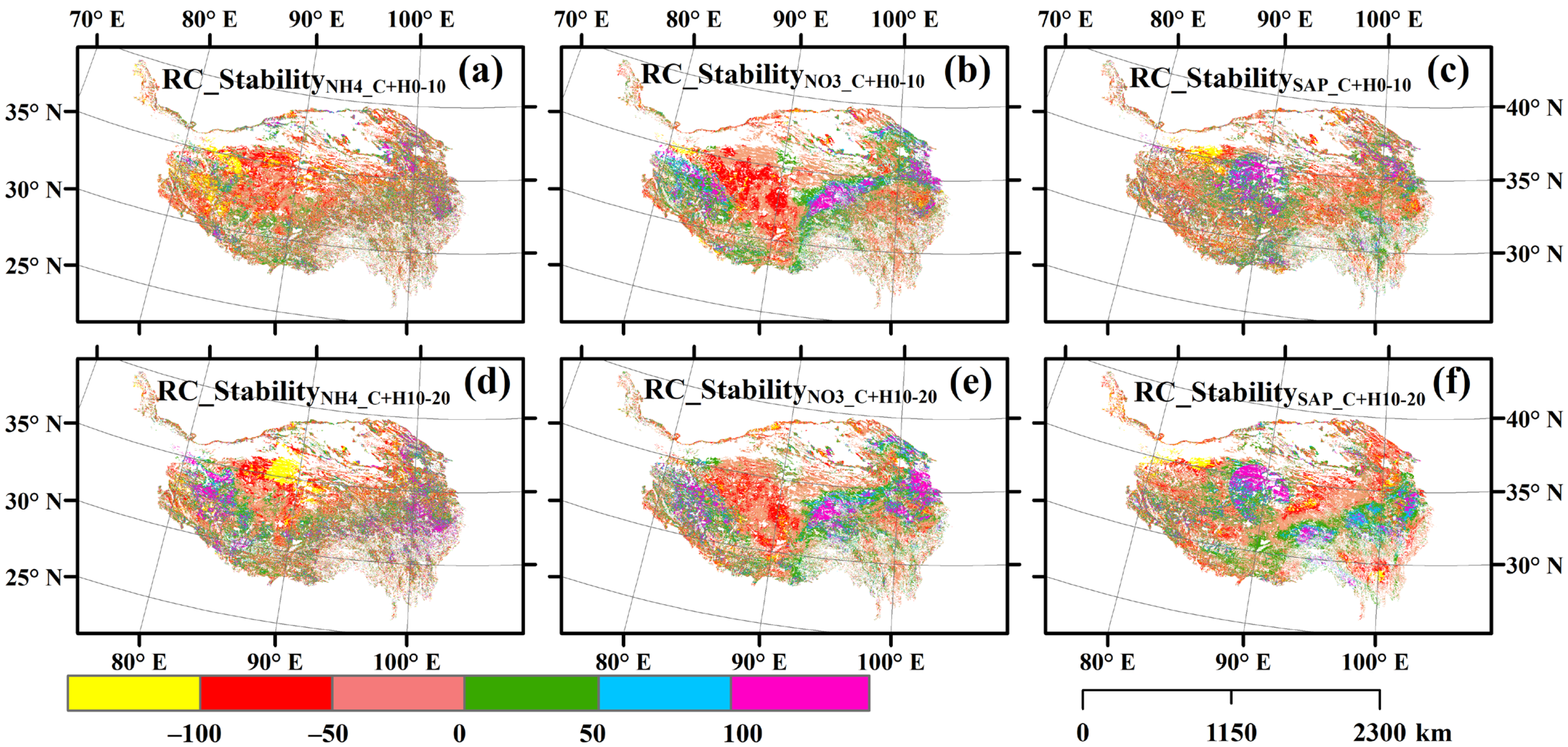

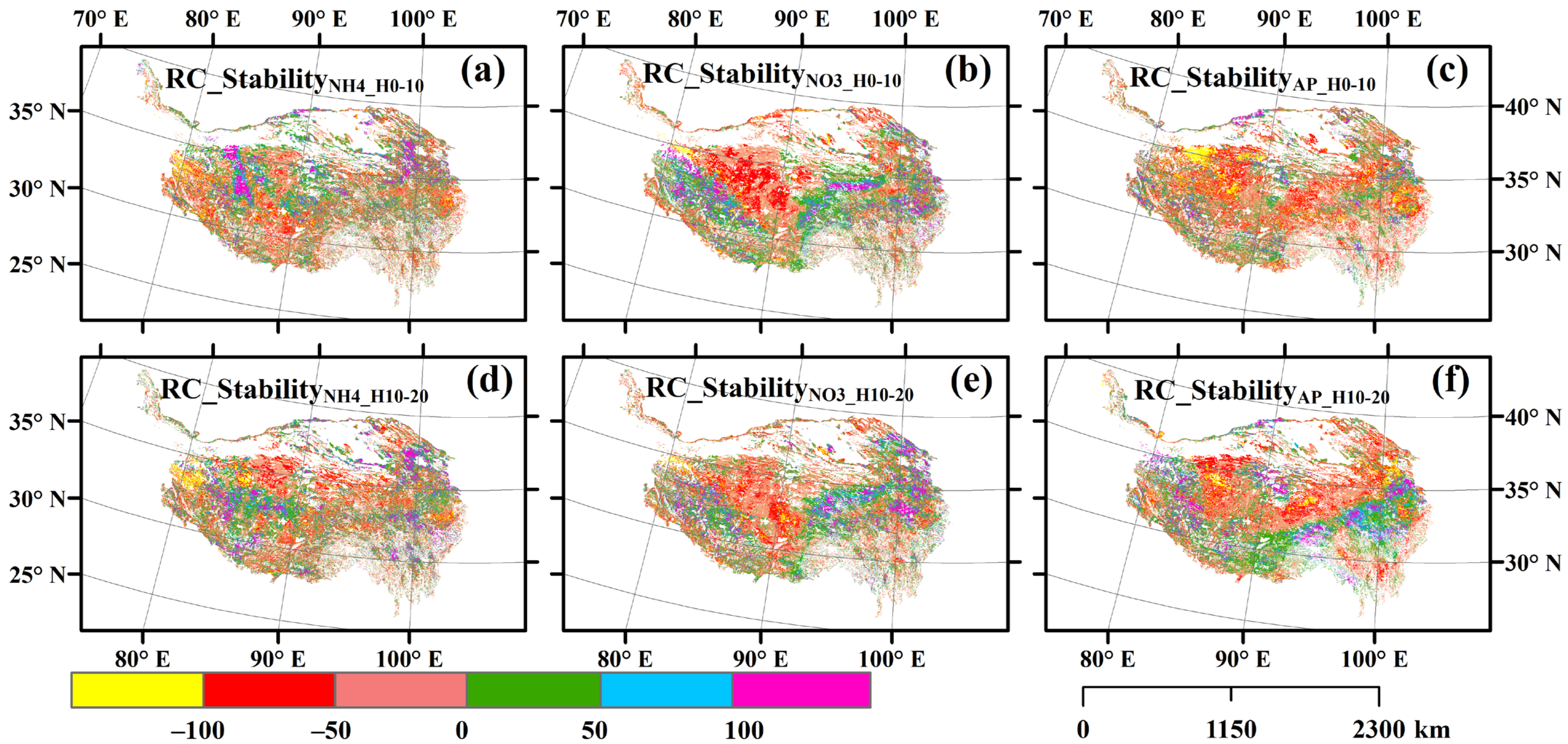
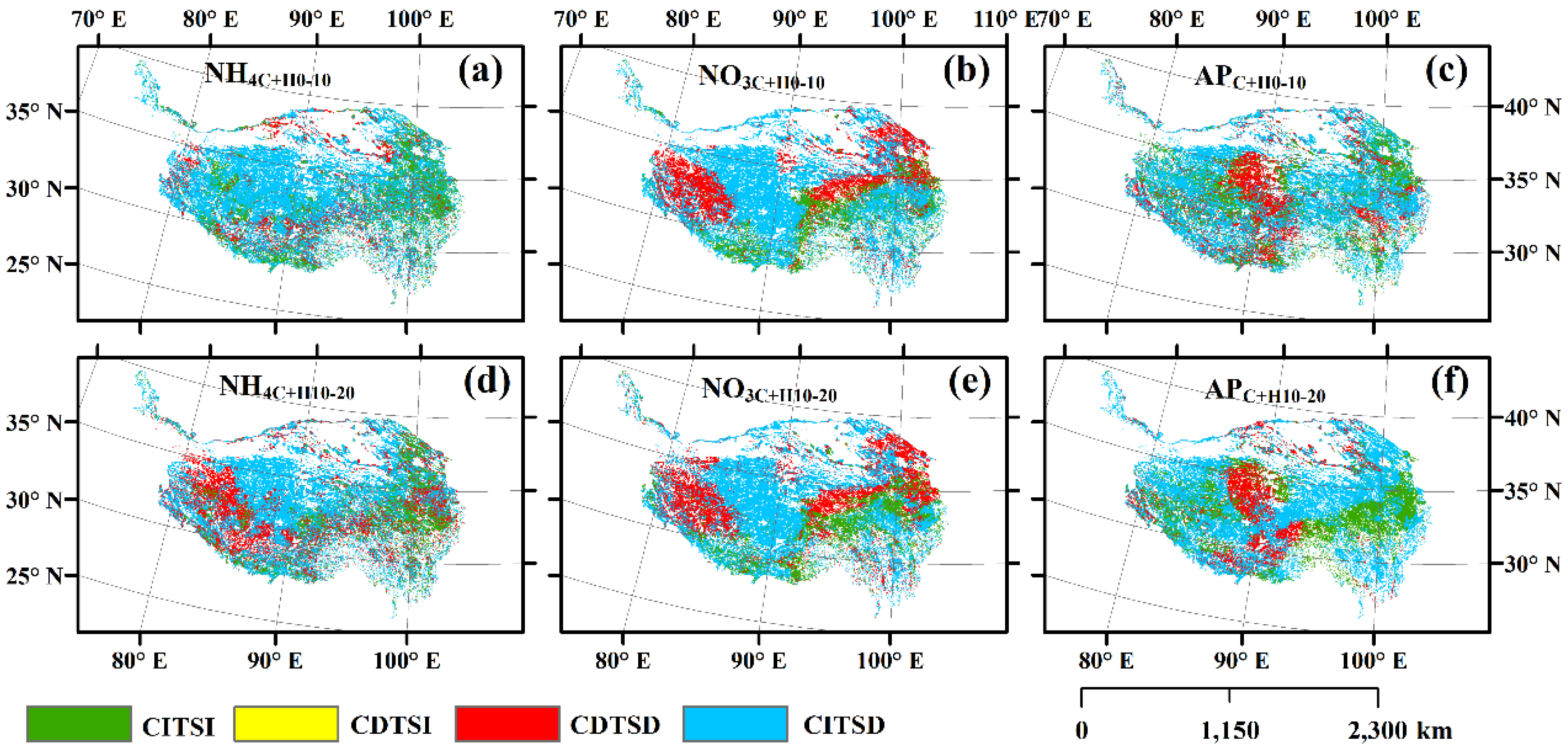
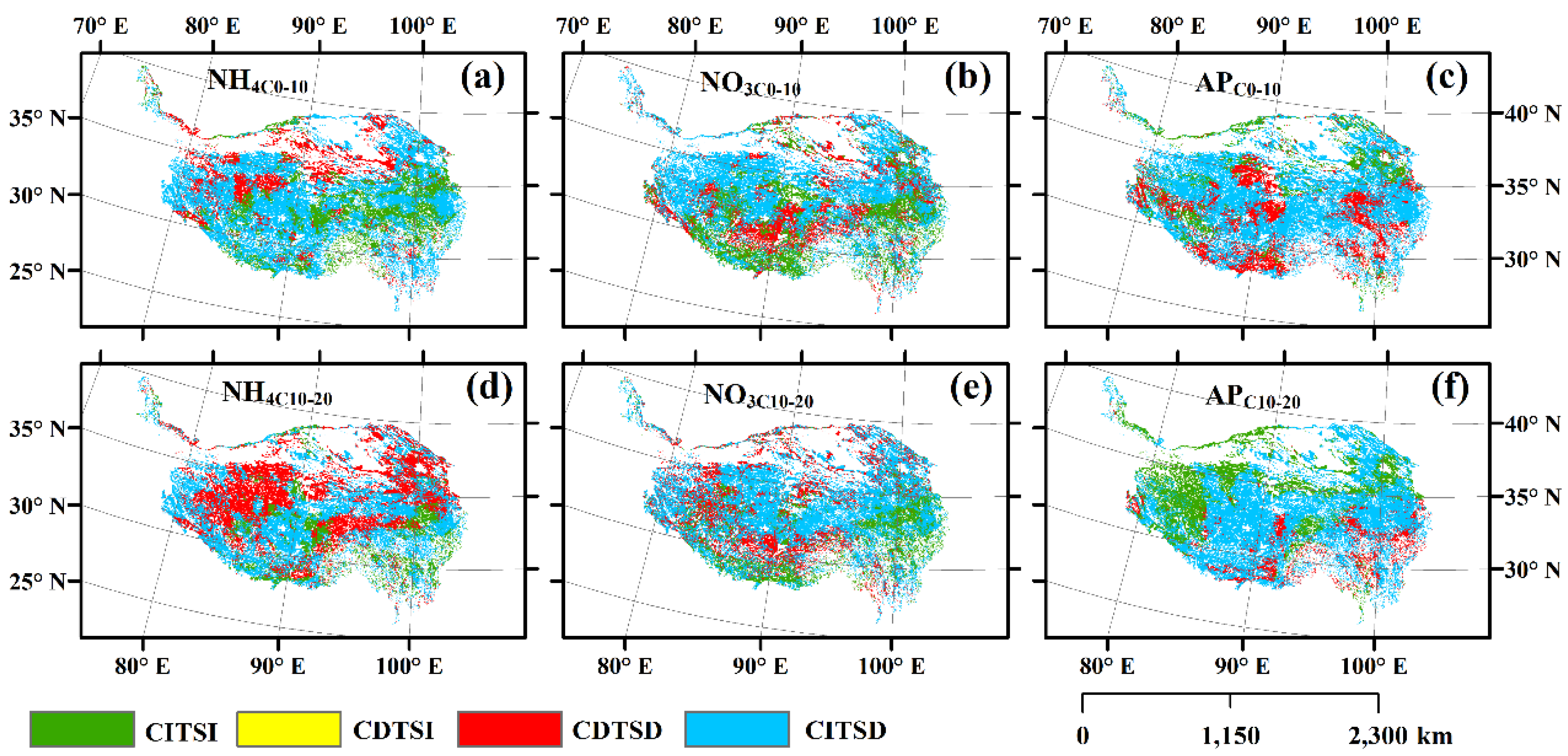
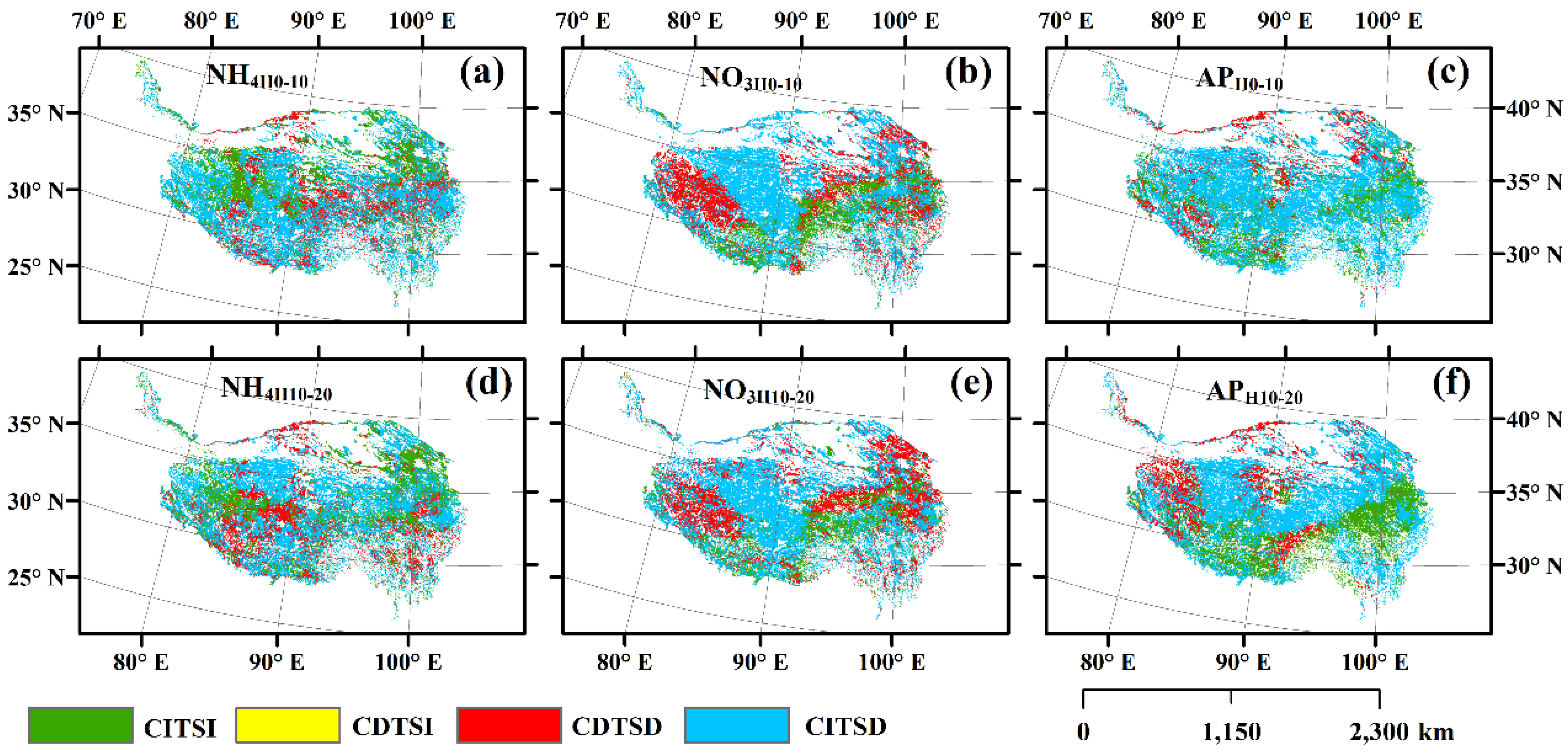
| Soil Depth | Scenes | Variables | Decrease | Increase | Across All Pixels | ||||
|---|---|---|---|---|---|---|---|---|---|
| Area Ratio (%) | Mean | Area Ratio (%) | Mean | Minimum | Maximum | Mean | |||
| 0–10 | C+H | RC_StabilityNH4_C+H0–10 | 40.44 | −9.36 | 59.56 | 16.78 | −256.73 | 369.88 | 6.21 |
| RC_StabilityNO3_C+H0–10 | 57.53 | −21.36 | 42.47 | 17.63 | −93.38 | 151.66 | −4.80 | ||
| RC_StabilityAP_C+H0–10 | 42.98 | −6.36 | 57.02 | 8.01 | −60.96 | 78.83 | 1.84 | ||
| C | RC_StabilityNH4_C0–10 | 47.22 | −12.15 | 52.78 | 14.12 | −57.13 | 84.63 | 1.72 | |
| RC_StabilityNO3_C0–10 | 51.17 | −5.34 | 48.83 | 6.44 | −28.29 | 45.46 | 0.41 | ||
| RC_StabilityAP_C0–10 | 64.51 | −13.42 | 35.49 | 10.13 | −77.74 | 74.94 | −5.06 | ||
| H | RC_StabilityNH4_H0–10 | 40.65 | −14.37 | 59.35 | 20.17 | −216.85 | 485.61 | 6.13 | |
| RC_StabilityNO3_H0–10 | 61.57 | −20.12 | 38.43 | 17.80 | −84.04 | 158.88 | −5.55 | ||
| RC_StabilityAP_H0–10 | 30.08 | −9.37 | 69.92 | 14.98 | −74.62 | 129.46 | 7.66 | ||
| 10–20 | C+H | RC_StabilityNH4_C+H10–20 | 66.30 | −12.98 | 33.70 | 16.01 | −355.95 | 511.87 | −3.21 |
| RC_StabilityNO3_C+H10–20 | 59.41 | −18.87 | 40.59 | 17.57 | −106.29 | 157.24 | −4.08 | ||
| RC_StabilityAP_C+H10–20 | 33.69 | −8.59 | 66.31 | 15.88 | −59.72 | 111.54 | 7.64 | ||
| C | RC_StabilityNH4_C10–20 | 70.02 | −14.44 | 29.98 | 8.88 | −178.58 | 164.35 | −7.45 | |
| RC_StabilityNO3_C10–20 | 60.37 | −6.20 | 39.62 | 5.93 | −47.44 | 71.16 | −1.39 | ||
| RC_StabilityAP_C10–20 | 44.13 | −8.85 | 55.87 | 15.86 | −49.30 | 125.98 | 4.95 | ||
| H | RC_StabilityNH4_H10–20 | 45.48 | −11.52 | 54.52 | 20.49 | −317.93 | 947.56 | 5.93 | |
| RC_StabilityNO3_H10–20 | 59.90 | −17.09 | 40.10 | 18.38 | −111.44 | 144.16 | −2.86 | ||
| RC_StabilityAP_H10–20 | 42.39 | −13.00 | 57.61 | 17.89 | −92.54 | 127.25 | 4.79 | ||
| Soil Depth | Scenes | Variables | Decrease | Increase | Across All Pixels | ||||
|---|---|---|---|---|---|---|---|---|---|
| Area Ratio (%) | Mean | Area Ratio (%) | Mean | Minimum | Maximum | Mean | |||
| 0–10 | C+H | RC_StabilityNH4_C+H0–10 | 68.51 | −53.35 | 31.49 | 63.09 | −3081.02 | 3852.73 | −16.68 |
| RC_StabilityNO3_C+H0–10 | 61.52 | −39.93 | 38.48 | 63.77 | −1324.64 | 1955.08 | −0.03 | ||
| RC_StabilityAP_C+H0–10 | 59.28 | −45.33 | 40.72 | 69.68 | −1404.24 | 2248.19 | 1.50 | ||
| C | RC_StabilityNH4_C0–10 | 60.85 | −37.43 | 39.15 | 45.88 | −970.25 | 1170.72 | −4.81 | |
| RC_StabilityNO3_C0–10 | 55.49 | −42.41 | 44.51 | 72.35 | −1084.25 | 1716.37 | 8.67 | ||
| RC_StabilityAP_C0–10 | 64.89 | −41.16 | 35.11 | 48.79 | −544.66 | 1649.93 | −9.58 | ||
| H | RC_StabilityNH4_H0–10 | 58.61 | −43.50 | 41.39 | 65.32 | −2238.86 | 2598.69 | 1.54 | |
| RC_StabilityNO3_H0–10 | 58.03 | −41.97 | 41.97 | 62.16 | −1230.5 | 1525.90 | 1.74 | ||
| RC_StabilityAP_H0–10 | 72.03 | −51.44 | 27.97 | 54.35 | −980.60 | 1340.81 | −21.86 | ||
| 10–20 | C+H | RC_StabilityNH4_C+H10–20 | 59.19 | −53.44 | 40.81 | 80.99 | −1695.25 | 2631.09 | 1.42 |
| RC_StabilityNO3_C+H10–20 | 58.02 | −38.19 | 41.98 | 69.73 | −1360.42 | 1422.81 | 7.12 | ||
| RC_StabilityAP_C+H10–20 | 60.60 | −42.38 | 39.40 | 63.94 | −1334.38 | 1973.22 | −0.49 | ||
| C | RC_StabilityNH4_C10–20 | 48.64 | −36.42 | 51.36 | 65.86 | −981.28 | 1483.55 | 16.11 | |
| RC_StabilityNO3_C10–20 | 60.80 | −44.12 | 39.20 | 60.81 | −1566.9 | 1550.42 | −2.99 | ||
| RC_StabilityAP_C10–20 | 63.92 | −36.42 | 36.08 | 49.00 | −1178.44 | 1014.69 | −5.61 | ||
| H | RC_StabilityNH4_H10–20 | 56.66 | −46.55 | 43.34 | 68.38 | −1496.57 | 1698.80 | 3.26 | |
| RC_StabilityNO3_H10–20 | 57.86 | −40.16 | 42.14 | 64.95 | −1049.03 | 2465.67 | 4.13 | ||
| RC_StabilityAP_H10–20 | 59.70 | −46.29 | 40.30 | 61.39 | −1172.73 | 1661.63 | −2.90 | ||
| Soil Depth | Scenes | Variables | CITSI | CDTSI | CDTSD | CITSD |
|---|---|---|---|---|---|---|
| 0–10 | C+H | NH4+-NC+H0-10 | 19.23 | 12.25 | 28.19 | 40.33 |
| NO3−-NC+H0-10 | 15.37 | 23.12 | 34.41 | 27.11 | ||
| APC+H0-10 | 21.68 | 19.03 | 23.95 | 35.34 | ||
| C | NH4+-NC0-10 | 22.04 | 17.12 | 30.11 | 30.74 | |
| NO3−-NC0-10 | 24.89 | 19.62 | 31.56 | 23.93 | ||
| APC0-10 | 12.40 | 22.71 | 41.80 | 23.09 | ||
| H | NH4+-NH0-10 | 24.73 | 16.65 | 24.00 | 34.62 | |
| NO3−-NH0-10 | 16.66 | 25.31 | 36.26 | 21.77 | ||
| APH0-10 | 17.90 | 10.06 | 20.02 | 52.03 | ||
| 10–20 | C+H | NH4+-NC+H10-20 | 15.53 | 25.27 | 41.02 | 18.17 |
| NO3−-NC+H10-20 | 16.39 | 25.60 | 33.81 | 24.20 | ||
| APC+H10-20 | 24.45 | 14.94 | 18.74 | 41.86 | ||
| C | NH4+-NC10-20 | 13.62 | 37.75 | 32.28 | 16.36 | |
| NO3−-NC10-20 | 16.77 | 22.44 | 37.94 | 22.86 | ||
| APC10-20 | 25.80 | 10.28 | 33.85 | 30.08 | ||
| H | NH4+-NH10-20 | 24.39 | 18.94 | 26.54 | 30.13 | |
| NO3−-NH10-20 | 15.85 | 26.29 | 33.61 | 24.25 | ||
| APH10-20 | 24.92 | 15.38 | 27.01 | 32.69 |
Disclaimer/Publisher’s Note: The statements, opinions and data contained in all publications are solely those of the individual author(s) and contributor(s) and not of MDPI and/or the editor(s). MDPI and/or the editor(s) disclaim responsibility for any injury to people or property resulting from any ideas, methods, instructions or products referred to in the content. |
© 2025 by the authors. Licensee MDPI, Basel, Switzerland. This article is an open access article distributed under the terms and conditions of the Creative Commons Attribution (CC BY) license (https://creativecommons.org/licenses/by/4.0/).
Share and Cite
Zhang, G.; Ding, R.; Sun, W.; Fu, G. Soil-Available Nitrogen and Phosphorus and Their Temporal Stability in the Tibetan Grasslands. Agronomy 2025, 15, 1255. https://doi.org/10.3390/agronomy15051255
Zhang G, Ding R, Sun W, Fu G. Soil-Available Nitrogen and Phosphorus and Their Temporal Stability in the Tibetan Grasslands. Agronomy. 2025; 15(5):1255. https://doi.org/10.3390/agronomy15051255
Chicago/Turabian StyleZhang, Guangyu, Rang Ding, Wei Sun, and Gang Fu. 2025. "Soil-Available Nitrogen and Phosphorus and Their Temporal Stability in the Tibetan Grasslands" Agronomy 15, no. 5: 1255. https://doi.org/10.3390/agronomy15051255
APA StyleZhang, G., Ding, R., Sun, W., & Fu, G. (2025). Soil-Available Nitrogen and Phosphorus and Their Temporal Stability in the Tibetan Grasslands. Agronomy, 15(5), 1255. https://doi.org/10.3390/agronomy15051255







